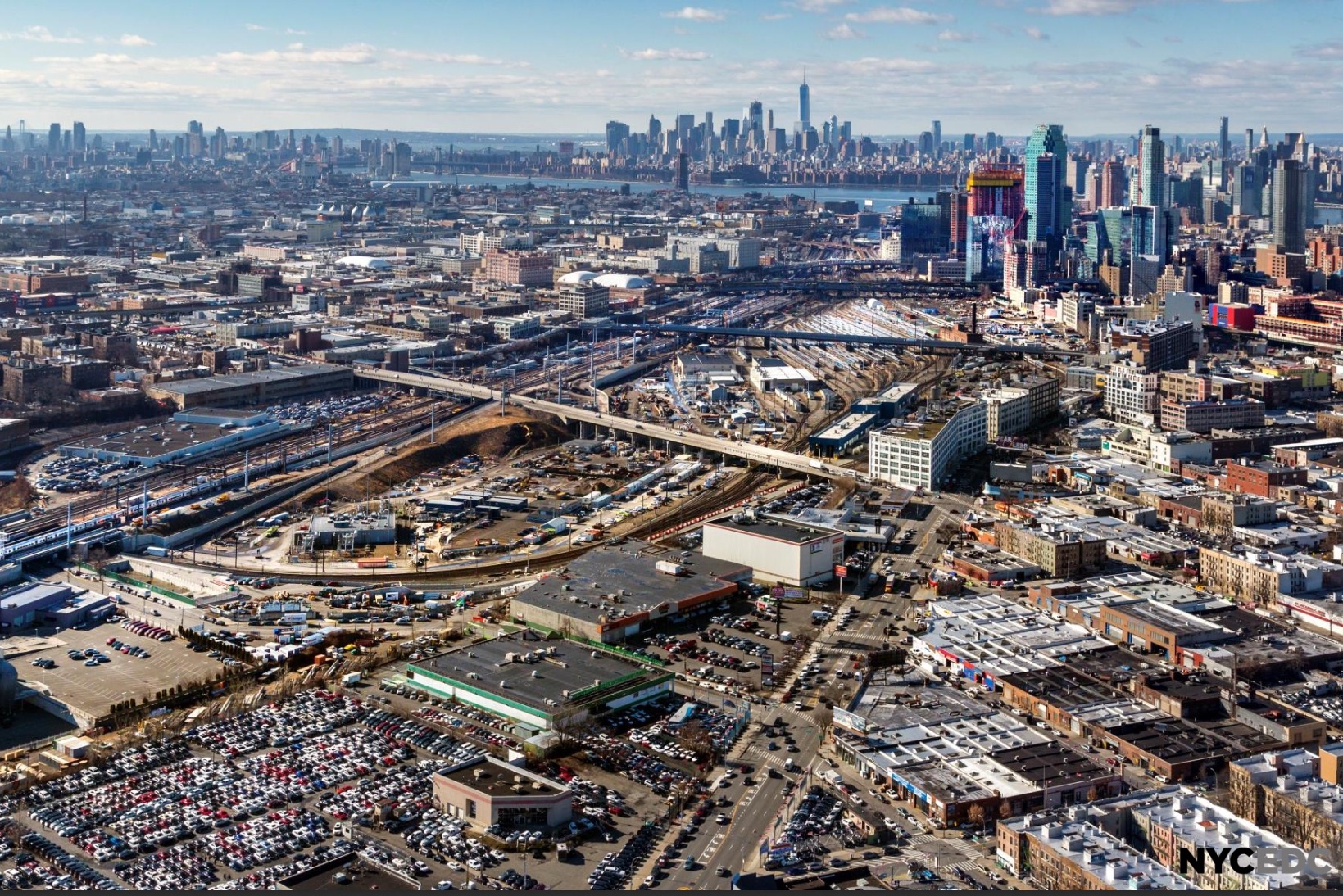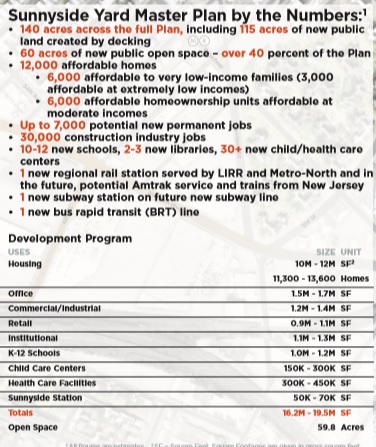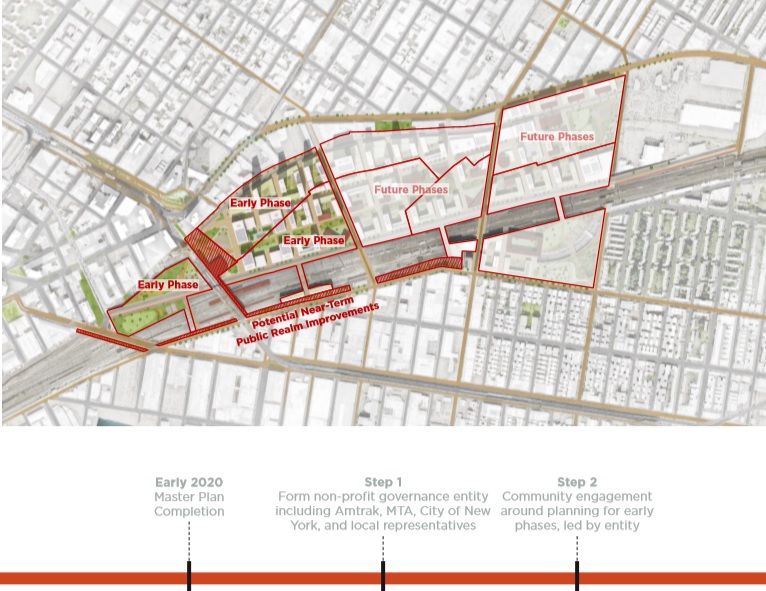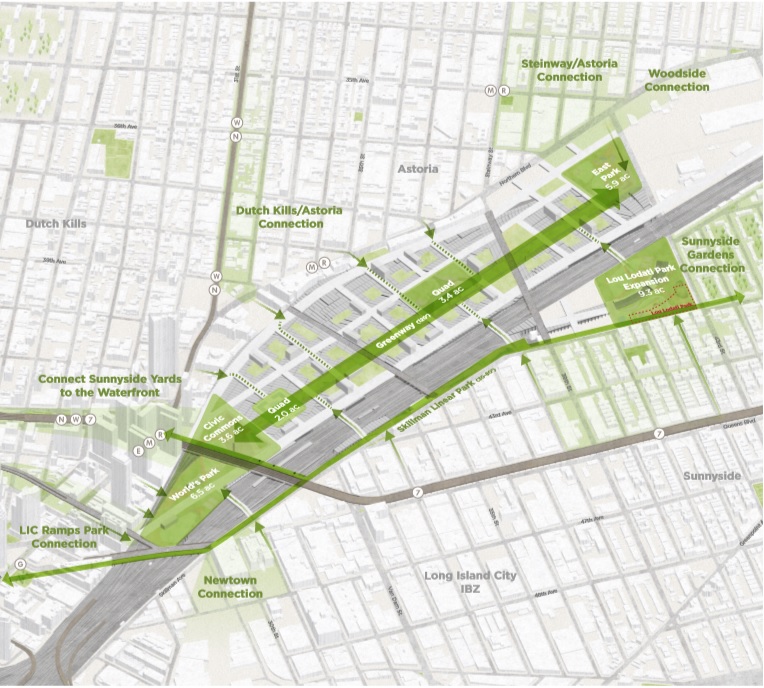
Sunnyside Yards, via EDC.
March 3, 2020 By Christian Murray and Michael Dorgan
City officials released the long-awaited Sunnyside Yard Master Plan today that calls for the construction of 12,000 affordable housing units, 60-acres of public space and a Sunnyside station that would be served by the Long Island Rail Road, Metro-North and potentially Amtrak.
The plan, put together by Amtrak and New York City, would be rolled out over several decades and involves decking over 115 acres of the 180-acre Sunnyside Yard. The cost to build the deck would be about $5.4 billion– with the total cost of the entire project about $14.4 billion.

Masterplan
The plan calls for between 10-12 new schools; approximately 1.7 million square feet of office space; 1.4 million square feet of commercial/industrial space; a major educational institution; and about 12,000 housing units—all to be affordable.
The plan also includes a new subway line, although it notes that it would be decades before that came to fruition.
The area toward Long Island City will feature larger-scale buildings, with the scale diminishing as development gets closer to Sunnyside Gardens.
The city plans to build the project in phases, with the development of the western section of Sunnyside Yard—the Long Island City end– to be built first.
City officials say that the masterplan is not a shovel ready plan, but rather a long-term framework to guide decisions. Additionally, it notes that it is also subject to change.
The first phase would involve building a train station that would be served by the Long Island Rail Road, Metro North and Amtrak. The station would be built in the yard by Queens Boulevard, near Queens Plaza.
The early phases would also see about 3,800 affordable housing units; a 1.3 million square foot research and education facility; 750,000 square feet of office space and 7.2 acres of park space. The open space would include a 6.5 acre park that would go between Thomson Avenue and Queens Boulevard adjacent to the Court Square neighborhood of Long Island City and a linear park up Skillman Avenue.

Sunnyside Master Plan
The city says that there is a need for the development of the 180-acre yard given the shortage of housing and the influx of 30,000 people to New York City each year. It notes that the Yard is in an ideal location and offers a relief valve for such pressure.
The masterplan follows about 18 months of public outreach and the city says that the feedback it generated during that period has shaped the plan. The city put together a 35-member steering committee, held three public meetings and put on several workshops to get community input.
The public meetings were heated at times, with protesters handing out fliers panning the proposed plan. At one meeting, held in Long Island City on Sept. 16, dozens of protesters from activist groups such as Queens Neighborhood United turned up and caused a disruption.
Then in November–separate from the meetings– about 80 protestors assembled on Skillman Avenue by the Yard holding signs that read: Queens is not for sale and Stop Sunnyside Yards. They said the funds needed to deck the yard would be better spent on restoring public housing.
“IF WE DONT GET IT – SHUT IT DOWN!!”
Opponents of #NYC‘s #EDC #SunnysideYard Plan demanded Billions $$ to be invested in #affordablehousing, repairing #subways #infrastructure & save small businesses yesterday.@queenspost @sunnysidepost @LICPOST #Queens #Queenspost #Sunnyside pic.twitter.com/LJITBDOhyD— Michael Dorgan (@MDorganNYC) November 26, 2019
Congresswoman Alexandria Ocasio-Cortez resigned from the steering committee in January. She said that the New York City Economic Development Corp., the lead agency for the city that worked on the plan, was not listening to the concerns of her constitutions.
The city’s focus on affordable housing stemmed from the feedback. The 12,000 housing units will be targeted for low income earners—with half being rentals and the other half owner-occupied.
The 6,000 rentals will be for people who earn up to 50 percent of the Area Media Income (approximately $48,000 for a family of three), with 3,000 of those units specifically for families earning less than 30 percent of the Area Median Income (about $29,000).
The owner-occupied units would be for residents who earn up to 100 percent of the AMI. They would be offered in a similar fashion of the Mitchell-Lama Housing Program.
The city received a lot of pushback at many of the meetings from people who feared that the development of the yard would lead to gentrification—where residents of the neighboring communities of Astoria, Sunnyside and Long Island City would be priced out.
The city, when it released a 2017 feasibility study, entertained building 24,000 housing units on the Yard, with only 30 percent of them being “affordable.”
Ocasio-Cortez and Council Member Jimmy Van Bramer wrote a joint letter to the EDC last year concerned that the plan would lead to people being priced out of Queens. State Sen. Mike Gianaris wrote a similar letter.

Greenspace and the Master Plan
The masterplan also aims to bring jobs and industry to the area.
The plan would see a major research and education institution come to the Yard, as well as office and commercial space. The city anticipates that such development would bring 7,000 permanent new jobs.
The city plans on building a linear park through the middle of the yard—called a central greenway—as well as a linear park on much of Skillman Avenue. Lou Lodati Park in Sunnyside would be expanded and park space would be created near Queens Boulevard in Long Island City.
The plan has already received some feedback from elected officials.
“The first step in this decades-long plan must prioritize infrastructure investments, and I am encouraged that the Master Plan includes the Sunnyside Station in its first phase,” said Rep. Carolyn Maloney in a statement.
Maloney said she was pleased that the plan includes schools, two libraries, park space and is 100 percent affordable housing.
The city aims to enter into a formal agreement with Amtrak that recognizes the Master Plan as the primary planning document for decking over the Yard.
The city and Amtrak will then establish a non-profit planning entity that is comprised of City, Amtrak, elected officials, and other key public stakeholders to oversee future efforts to realize the plan.
The plans, however, would have to go through an extensive public review process before becoming a reality. Furthermore, they are likely to be rolled out over several decades.
6 Comments

Few remember that in 1998, as part of the proposed MTA LIRR Eastside Access project, construction of a passenger station was considered for Sunnyside Yard. It would have provided access to the growing Long Island City business and residential district. Fast forward twenty one years. The MTA has still not advertised and awarded a contract for the new Sunnyside Yard LIRR Station (that was to be built at Queens Blvd. & Skillman Avenue). There is no significant funding included for this project within the current $51 billion MTA 2020 – 2024 Five Year Capital Plan. The next opportunity for funding would be under the upcoming MTA 2025 – 2029 Five Year Capital Plan. The same is true for the proposed new City Hall and Albany budgets. No one has promised any funding to support any planning feasibility studies for “a new Rapid Transit Bus Line connecting Queens with Midtown Manattan or a future new subway line as promised in the master plan..
Can the existing sewer, water and utility systems support such a huge development project? There is also the challenge of expanding fire, police, sanitation, schools and other critical municipal services to support the thousands of new residents and commercial development that would come with this project..
(Larry Penner — transportation historian, advocate and writer who previously worked 31 years for the Federal Transit Administration Region 2 NY Office. This included the development, review, approval and oversight for grants supporting billions in capital projects and programs on behalf of the MTA, NYC Transit, LIRR, Metro North, MTA Bus, NYC DOT along with 30 other transit agencies in NY & NJ).
Ocasio-Cortez and Council Member Jimmy Van Bramer wrote a joint letter to the EDC last year concerned that the plan would lead to people being priced out of Queens. State Sen. Mike Gianaris wrote a similar letter. lol yeah keep those letters coming. Keep voting these losers in. The power of their pens is essential!!!
Great…While the communists play simcity with the people’s money, the rest of the city is deteriorating fast.
We will regret the affordable housing component, we always do. Make all new housing market the older housing stock will phase itself into lower end housing. That solution works better than clustering twelve thousand “low income” families in one area. That’s what the housing projects did and look how well that works out.
This is “affordable housing”, it is not the same things as low-income housing.
These places will not be affordable and they will not go to low-income people.
@John – To quote the article, “ The 12,000 housing units will be targeted for low income earners—with half being rentals and the other half owner-occupied.
The 6,000 rentals will be for people who earn up to 50 percent of the Area Media Income (approximately $48,000 for a family of three), with 3,000 of those units specifically for families earning less than 30 percent of the Area Median Income (about $29,000).